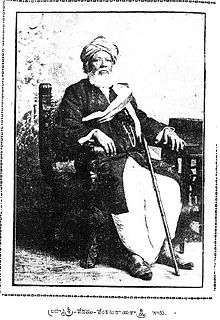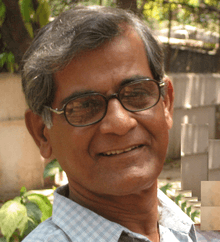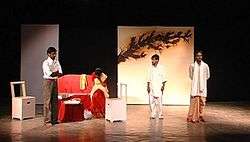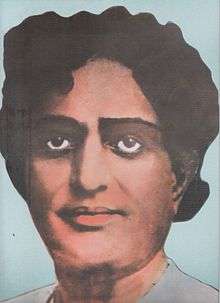Telugu theatre
|
"Prasna" a play directed by Murali Basa at University of Hyderabad, written by Gollapudi Maruthi Rao | |
| Industry |
Drama Theatre |
|---|---|
Number of locations |
Andhra Pradesh Telangana[1][2] |
Key people | Film, Television and Theatre Development Corporation[3] |
Telugu theatre also known as Rangasthalam is an Indian theatre in the Telugu language, based in the states of Andhra Pradesh, and Telangana.[4] Gurazada Apparao wrote the play, Kanyasulkam in 1892, which is often considered the greatest play in the Telugu language.[5] C. Pullaiah is cited as the father of Telugu theatre movement.[6][7]
Vemuri Gaggaiah was an important member of the Mylavarama Bala Bharathi Nataka Samajam in Mylavaram, Krishna district during 1913-28. Through "Mylavaram Theatre". Gaggaiah became a household name for mythological roles. He won recognition in drama as Yama, god of death, in Sati Savitri, as the demon Hiranyakasipu in Bhakta Prahlada. Some other prominent roles were as the eponymous Mymvana, and as Jalandhara in Sati Tulasi. [8] Tirupati Venkata Kavulu have dramatised several of the Hindu epics into dramas and plays consisting of singable verses set to perfect meter. Several of their plays, especially pandavodyogavijayalu have been widely known among many drama clubs and audiences across Andhra Pradesh.[9] The Nandi Natakotsavam Awards are given every year by the government for achievements in Telugu theatre.[4][10][11]
Associated figures


Kalyanam Raghuramaiah, A recipient of the Sangeet Natak Akademi Award, and the Padmashri, He was known for the roles of Krishna or Dushyantha, Bhavanisankar, Narada etc. He performed those roles for about 60 years. He indulged in elaborate raga alapana, based on different ragas while rendering padyams.[14][15][16] One of the finest method actors, He had the ability to sing padyams and songs through whistle, by putting his finger in mouth and producing the whistle or flute sound (meaning Eela in Telugu). He has acted in various dramas and gave more than 20,000 stage performances.[5] He was called the "Nightingale of the Stage" by Rabindranath Tagore[14] Balijepalli Lakshmikantam was a dramatist remembered for the masterpiece Harischandra (Satya Harischandriyamu) written in 1924.[17][18]
Peesapati Narasimha Murty was trained under Kilambi Krishnamacharyulu in 1934 and started his acting career with Rangoon Rowdy in 1938. In 1946, he enacted as Sri Krishna in Pandavodyoga Vijayalu. He won the prize as best Sri Krishna in the “Akhilandhra Pandava Udyoga Vijayalu” competitions held in 1949 at Guntur.[8] Sthanam Narasimha Rao was well known for playing stunning female characters and was a recipient of a Padma Sri Award. His depiction of the Sringara rasa as Satyabhama in Srikrishna tulabharam kept audiences spellbound. Equally enchanting performances in Roshanara, Deva Devi in Vipranarayana and the eponymous Chintamani made his place in Telugu theater permanent. His most memorable acting, however, was as Madhuravani in Gurajada Appa Rao`s comedy Kanyasulkam. Sthanam had over 1,500 performances to his credit. His productions of classics on All India Radio include Kanyasulkam and Ganapati. He acted in Telugu films such as (Radhakrishna in 1939 and Satyabhama in 1941) and authored a book about his vast acting experience entitled, Natasthanam. He was felicitated in Rangoon and gifted golden crown in 1938. [19][20]
Chittooru Nagaiah was closely connected to Rama Vilasa Sabha, a cultural association in Chittoor. He performed several stage plays, such as Sarangadhara, Viswamithra Chitra Nilayam, Savitri, Bruhannala and Ramadasu, and staged the roles of Telugu saint-poets Pothana, Vemana, Ramadasu, and Tyagaraja.[21] Banda Kanakalingeshwara Rao was a member of Kendriya Sangeet Natak Akademi since 1952 and Andhra Pradesh Sangeet Natak Akademi since 1957.[14][15][16][20][22] Gollapudi Maruti Rao's volume of essays on theatre, Telugu Nataka Rangam, was prescribed as a textbook for the Department of Theatre Arts, Andhra University, Visakhapatnam (1967). He published two research articles appeared in Andhra Vignana Sarvaswam (Telugu Encyclopedia) 11th volume: "History of the development in 'Thought' and 'Technique' of Telugu Play-writing" and "Amateur Theatre – its origin and growth in relation to the World Amateur Theatre movement.[23] His Telugu play Vandemaataram, the first one in Telugu about the Sino-Indian War, was published by Andhra Pradesh State Information & Public Relations Department, (1963).[23][24] Aatreya's works on social reform, transformation and universal peace, include his 10 Natakams (plays) and 15 Natikas,[25][26] which include Bhayam ("Fear"), Viswa Shanti ("Universal Peace"), Kappalu ("Frogs"), Goutama Buddha, Ashoka Samrat, Parivartanam, Edureeta and Tirupati.[27]
Rathna Shekar Reddy is a theatre artist from Telangana,[28] and an alumnus of the Lee Strasberg Theatre and Film Institute.[29] best known for his critically acclaimed theatre productions like Purushotham, Dominic Wesley, Last Wish Baby, Gregor Samsa etc[30][31][32] His body of work includes The Imaginary Invalid,[33] Fiddler on the Roof,[34] Purushotham, Wait Until Dark,[35] The Last Wish Baby.[36] Reddy conducts theatre workshops which run full,[37] trains actors for both stage and cinema and produces and directs plays for both Samahaara and outside institutions like schools, colleges, corporates and others.[38] in which he plays a negative lead, Antha Scene Ledu,[39] lead in the award winning Naa Bangaaru Thalli[40] and others.
Kinds of theatre
- Telugu theatre is having its roots from almost 2nd century BC. the theatre of Telugu can be deveded into various kinds. the major kinds are Folk theatre, Padya Natakam, Parishath natakam, Gadyanatakam or social plays, the prayoga natakam or experimental plays and the Street theatre.[8][19][20]
- Folk Theatre .. Telugu people who lives in both the States of Telangana and Andhra Pradesh having very rich folk Theatrical Traditions. Chindu Bhagavatham or Chindu yakshaganahese kind of forms. research scholars like Dr. Bhikshu and others proved that there somany theatrical elements in these forms.
Chindu bhagavatam or yakshaganam : this is eminent Folk theatre form of Telangana state. there were thousands of scripts written for the performance of chindu. there are two major traditions in chindu Yakshaganam. one is traditional art for the sake of the cast related rituals. and the other one is occasional performances for entertainment. This tradition is being performed by chindu madigas who are dependent cast people of madiga community. chindu madigas plays the cast myths Adi jambapuranam and yellamma katha for the rituals of their cast. for entertainment they play myths folk tales and histarical subjects. chervirala Bhagayya was one of the prominent writer who wrote more than 100 yakshaganas. chindu yellamma gaddam narendar gaddam srinivas shindu shyam aresome of the prominent performers of the chindu yakshaganam.[8][14][15] [16][19][20]
Padya Natakam
As it is started from the Padya Natakam, The people of Telugu Theatre used to render the poems for a long time. Plays like 'Satya Harischandra', 'Kurukshetram', 'Gayopaakyanam' are the well known plays. poems like "chelliyo chellako". " Bava eppudu vachiteevo" are used to render by the every common man in every part of the village. The actors used to sing these many more times.
The interesting feature in Telugu theatre is the main roles are cast by two persons and named as "okatava (first)" "rendo (the second)", for example okatava krishnudu (first krishna), rendava krishnudu (second krishna). Most of the performances start at late nights and will continue till early mornings.[20][22]
Parishat Natakam
Parishat is a traditional Theatre event conducted annually at different places in Andhra Pradesh. It spans about three to four days having a competition of plays for the Parishatnatakam groups spread across the state. The present baseline study reveals that fifty one Parishats were conducted in Andhra Pradesh during the year 2011 and out of them, 41 Parishats have been conducted in coastal region of Andhra Pradesh. Though only 10 Parishats are situated in the other parts of Andhra Pradesh.[20][22]
Gadya Natakam
After staging the play vyvahara Dharma Bhodhini of veereselingam in 1890, the scenario of Telugu theatre has changed. Most of the writers have been started writings on the socio economical problems raised in the society. They have also written political satires. The comedy play like 'Chintamani" is an all-time favorite of Andhra people.[20][22]
The other most important feature in the Telugu theatre is "Parishid Play". These Parishid plays have taken place for the improvements in Telugu theatre and lead to a realistic movement rather than the normal epic stories happened before that time. The parishid also established a realistic movement of Telugu theatre. As against the existing tradition of musical plays i.e. padya natakam, it pleaded for socially relevant theatre. To achieve this, it held annual competitions regarded as a touch stone of artistic excellence, insisting that only social or one-act drama within the previous five years was eligible to participate and that women should enact female roles. The time factor of 1hr is also another important factor in these parishid plays.[20][22]
Prayoga Natakam or Experimental Drama
This is a differient kind of plays written and performed by various plays. major place for theses kind is educational institutes like universities and the colleges where the theatre is a part of their education.[20][22]
Major contributors
|
|
References
- ↑ Open-air auditorium to be constructed in Kakinada. The Hindu (2012-12-23). Retrieved on 2014-01-21.
- ↑ Telugu Teachers outside Andhra Pradesh,Telugu Teachers outside Andhra Pradesh,Telugu Teachers outside Andhra Pradesh. Teluguwebsite.com. Retrieved on 2014-01-21.
- ↑ "Government announces Nandi Awards committee members". Ragalahari.com. 2007-12-23. Retrieved 2012-10-13.
- 1 2 October 13, 2012 11:45 pm (2010-10-08). "Nandi Natakotsavam Awards". India Scanner. Retrieved 2012-10-13.
- 1 2 20th Century Telugu Luminaries, Potti Sriramulu Telugu University, Hyderabad, 2005
- ↑ Narasimham, M. L. (November 7, 2010). "SATI SAVITHRI (1933)". The Hindu. Retrieved July 8, 2011.
- ↑ Bhagwan Das Garg (1996). So many cinemas: the motion picture in India. Eminence Designs. p. 86. ISBN 81-900602-1-X.
- 1 2 3 4 Luminaries of 20th Century, Potti Sreeramulu Telugu University, Hyderabad, 2005.
- ↑ Various (1987). Encyclopaedia of Indian literature vol. 1. Sahitya Akademi.
- ↑ Kavirayani, Suresh (2012-10-13). "2011 Nandi Awards winners list". The Times of India. TNN. Retrieved 2012-10-13.
- ↑ "Andhra Pradesh / Hyderabad News: ETV, SVBC, DD sweep Nandi awards". The Hindu. 2010-11-11. Archived from the original on 2013-05-30. Retrieved 2012-10-13.
- ↑ Vedam Venkataraya Sastry in Makers of Indian Literature; Biography by Vedam Venkataraya Sastri, Sahitya Akademi, 1976)
- ↑ "'Theatre is thought provoking'". 24 October 2013 – via The Hindu.
- 1 2 3 4 Article in Eenadu http://beta.eenadu.net/Cinema/Cinemainner.aspx?qry=gnapaka
- 1 2 3 "He was ahead of his times - Tirupati". The Hindu. 2013-05-10. Retrieved 2016-05-30.
- 1 2 3 "pranaism: తెలుగు నాటకరంగ ప్రముఖుల ఫోటోలు (సశేషం)". Pranaism.blogspot.in. Retrieved 2016-05-30.
- ↑ Nata Ratnalu, Mikkilineni Radhakrishna Murthy, Second edition, 2002, pages 370-72
- ↑ "Balijepalli Lakshmikanta Kavi".
- 1 2 3 "AndhraNatakam Artists". Andhranatakam.com. Retrieved 2016-12-01.
- 1 2 3 4 5 6 7 8 9 Nata Ratnalu, Mikkilineni Radhakrishna Murthy, Second edition, 2002.
- ↑ Amazon / Books / Indian actor Chittoor V. Nagaiah: A Monograph, by K. N. T. Sastry (Author)
- 1 2 3 4 5 6 Luminaries of 20th Century, Potti Sreeramulu Telugu University, Hyderabad, 2005
- 1 2 "Uphold values, says Gollapudi". The Hindu. Chennai, India. 6 February 2011.
- ↑ "telugu colours,complete biography of gollapudi maruthi rao".
- ↑ Athreya
- ↑ ACHARYA ATHREYA (1 January 1955). "ANTYARPANA (NATIKA)". VISHALANDRA PRACHURANALAYAM – via Internet Archive.
- ↑ Athreya
- ↑ "Rathna Shekar Reddy".
- ↑ "Men and women merely players". 30 July 2010 – via The Hindu.
- ↑ "News Archives: The Hindu".
- ↑ "Novel adaptation". 28 February 2014 – via The Hindu.
- ↑ "The Cast - Ente..The Movie".
- ↑ The Hindu : Young World : The best medicine
- ↑ The Hindu : Metro Plus Hyderabad : Creating a new niche
- ↑ http://www.thehindu.com/todays-paper/tp-features/tp-youngworld/article889529.ece The Hindu : FEATURES / YOUNG WORLD : Drama time
- ↑ http://www.hindu.com/fr/2011/01/07/stories/2011010750360400.htm The Hindu : Friday Review Hyderabad / Drama : A laugh riot
- ↑ "'Amateurs keep theatre alive': Rathna Shekar - Deccan Chronicle".
- ↑ "Sons of the soil". 2 March 2014 – via The Hindu.
- ↑ Antha Scene Ledu
- ↑
External links
| Wikimedia Commons has media related to Performing arts in India. |


